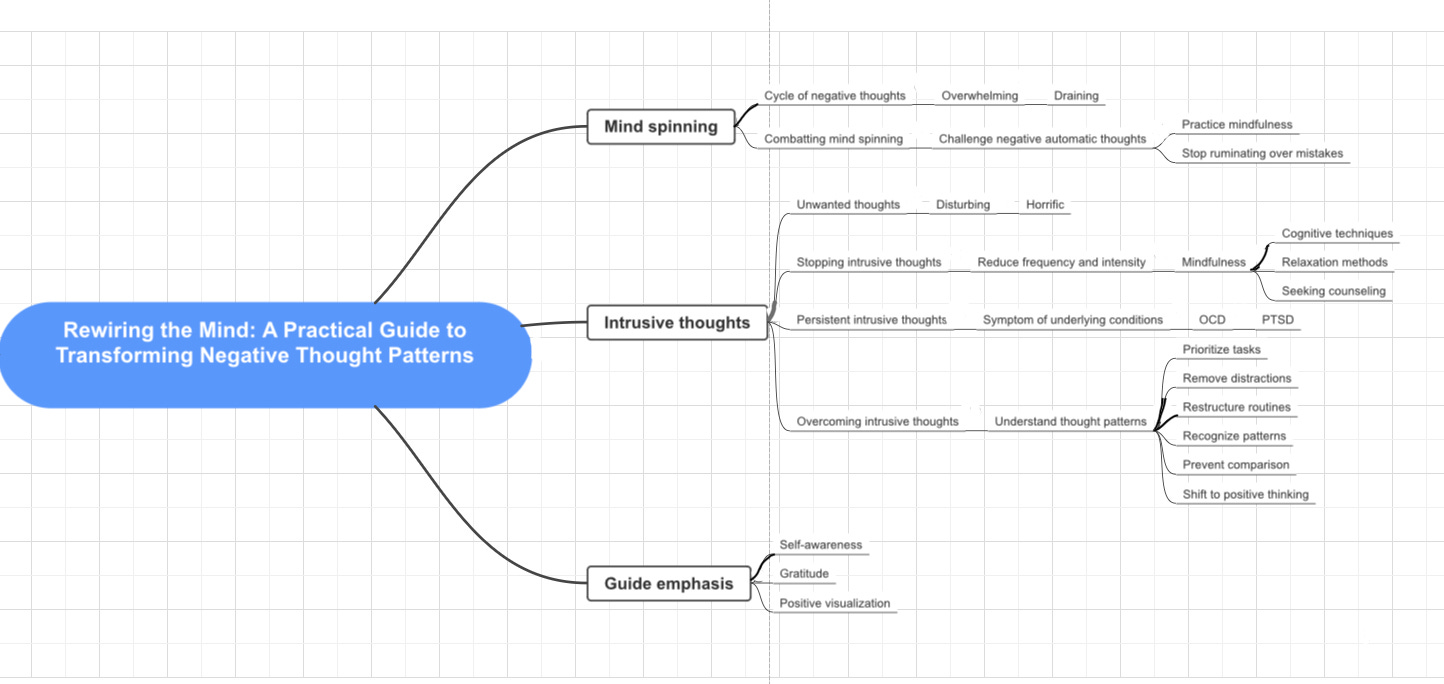Rewiring the Mind: A Practical Guide to Transforming Negative Thought Patterns
Based on lived experience, This time it works!
How many times have you caught yourself spinning around your thoughts in your head while you’re trying to focus on something?
Topics:
What is mind spinning
What are intrusive thoughts
What are thought patterns
How to be more mindful
Key takeaways
What is Mind Spinning? Mind spinning refers to a state where your mind gets caught up in a cycle of negative, repetitive thoughts that seem to spin endlessly. It's a form of rumination where you fixate on the same worries, fears, mistakes or perceived failures over and over again. This mental looping can feel overwhelming and draining.
Challenging Negative Automatic Thoughts:
One effective technique is to challenge the negative automatic thoughts that fuel mind spinning. Our minds can distort reality through cognitive biases like catastrophizing, overgeneralizing, or negative filtering. Question the evidence for these thoughts:
Is this thought 100% true or am I assuming?
Am I viewing this situation from the most negative perspective?
Is there another way to look at this?
Reframe negative thoughts in a more balanced, realistic way based on facts, not distortions.
How to Control Negative Thoughts
Beyond challenging specific thoughts, there are strategies to gain control over negative mental loops:
Practice mindfulness to become aware when your mind is spinning so you can disengage
Use a "stop" technique like snapping a rubber band on your wrist to break the cycle
Distract yourself by getting up and doing something else for 15 minutes
Talk to a friend about what's on your mind to get another perspective
With practice, you can catch mind spinning earlier and implement techniques to short-circuit it.
Stopping Rumination Over Mistakes
It's natural to think about mistakes, but ruminating prevents learning and growth. Try these tips:
Acknowledge you made a mistake, but don't beat yourself up over it
Reflect on what you can learn, then consciously let it go
If your mind circles back, gently redirect your thoughts
Practice self-compassion - we all make mistakes sometimes
The key is noticing when your thoughts become unproductive repetition. Be proactive about shifting your mind to something more positive and constructive.
What are intrusive thoughts
Intrusive thoughts are unwanted, unintentional thoughts, images or urges that enter your mind unexpectedly. They can be disturbing, distressing or even horrific in nature. Common examples include thoughts about harming yourself or others, inappropriate sexual or violent thoughts, doubts, or obsessive worries.
Why Do We Have Intrusive Thoughts?
While their content can be unsettling, intrusive thoughts are actually quite normal and experienced by most people to some degree. They are often completely disconnected from our true values, beliefs and intentions. Potential causes include:
Stress and anxiety amplifying "what if" thoughts
Cognitive biases making us dwell on the unacceptable
Attempts by the brain to make sense of disturbing ideas
Purely random firing of neurons
Having intrusive thoughts does not make you a bad person. The thoughts are not reality unless you dwell on or act upon them.
Can We Stop Intrusive Thoughts?
While you can't fully control when intrusive thoughts arise, there are ways to reduce their frequency and intensity:
Practice mindfulness to notice thoughts without judging them
Use cognitive techniques to reframe and let go of thoughts
Reduce overall stress through relaxation methods
Seek counseling for persistent, distressing intrusive thoughts
The goal isn't to eliminate intrusive thoughts entirely, which is difficult, but to change your relationship with them so they don't cause distress.
What Else Could It Be?
In some cases, persistent intrusive thoughts may be a symptom of an underlying condition like:
Obsessive-compulsive disorder (OCD)
Post-traumatic stress disorder (PTSD)
Depression or other mental health issues
Certain neurological conditions
- If intrusive thoughts are frequent, disturbing, and interfering with your daily life, it's a good idea to discuss them with a mental health professional for proper diagnosis and treatment.
What are thought patterns:
If you feel like you’ve lost the control of your life, and popping up tasks drain all your energy and time during the day, and you either want everything to come to an end or be like the old days, here is what you do to transform your life:
1. For one week, dedicate 10 minutes each day to write down everything that you do throughout the day.
2. At the end of the day, reflect on your feelings and thoughts before, during, and after each task.
3. At the end of the week, prioritise what gets results, remove what drains your energy and focus, restructure your tasks and routines to make them easier and free up some time.
What is a thought pattern: The second step will help you to know your thought patterns, recognizing patterns allows us to predict and expect what is coming. The process of pattern recognition involves matching the information received with the information already stored in the brain.
How to recognize your own patterns: By writing down the thought, action, and feeling. For example if you compare yourself to other people in your age, and you *think that they are more successful than you and you’re not enough, then you might drop what you are doing and go to social media or just sleep, after that you’re feeling more drained and depressed and self sabotaging makes you stay in bed, and that’s a sick cycle. So the pattern here is: comparing yourself to others, self sabotaging, wasting time thinking you’re not enough to prove yourself that’s true by doing absolutely nothing, self sabotage more. To stop all of this, you can prevent comparison by using simple methods like: not scrolling on social media, improving self-esteem, and savoring.
How to change them: Here are some useful and practical ways to Shifting to Positive Thinking:
Self-awareness: Recognizing Negative Thoughts
• Observe and identify negative thoughts, often stemming from self-doubt, fear, or past experiences.
• Train yourself to notice and address these negative thoughts.
Challenging Negative Beliefs
• Replace negative beliefs with more positive and realistic ones.
• For example, reframe negative thoughts like "This laundry never ends" as "I can't wait for fresh, clean sheets on my bed tonight."
Practicing Gratitude
• Acknowledge and practice gratitude daily to focus on positive aspects of life.
• Regularly practice gratitude to maintain a more optimistic outlook.
Surroundingself with Positive Inputs
• Surround yourself with positive inputs that uplift and inspire you.
• Seek out activities that bring joy and fulfillment.
Positive Affirmations
• Create a list of affirmations that resonate with you and repeat them daily.
• Reprogram your subconscious mind to embrace a more optimistic mindset.
Setting Realistic Goals
• Break down larger goals into smaller, manageable steps.
• Celebrate progress along the way and don't be too hard on yourself if setbacks occur.
Embracing Positive Visualization
• Spend time visualizing your goals and desired positive outcomes.
Reframing Failure
• View failures as opportunities for growth and learning.
• Embrace a growth mindset to maintain a positive perspective.
Spreading Positiveity
• Share positivity with others through acts of kindness, compliments, and supportive gestures.
Useful Tips for Beginners
Recognize Mind Spinning: Identify when your mind is spinning by becoming aware of repetitive, negative thoughts. This awareness is crucial to breaking the cycle.
Challenge Negative Thoughts: Question the evidence for negative thoughts and reframe them in a more balanced, realistic way. This helps to reduce mental looping and gain control over negative thoughts.
Practice Mindfulness: Regular mindfulness practice helps you notice when your mind is spinning and disengage from the cycle. Use techniques like snapping a rubber band or distracting yourself to break the loop.
Stop Rumination Over Mistakes: Acknowledge mistakes, reflect on what you can learn, and let them go. Practice self-compassion and redirect your thoughts to more positive and constructive ones.
Recognize Thought Patterns: Identify patterns in your thoughts, actions, and feelings. Write them down and reflect on how they affect your life. This helps you predict and expect what's coming and make changes to break cycles of negative thinking.
Practice Positive Thinking: Focus on self-awareness, challenging negative beliefs, practicing gratitude, and surrounding yourself with positive inputs. Use affirmations, set realistic goals, and visualize positive outcomes to maintain a positive mindset.
Seek Help: If intrusive thoughts are persistent and distressing, seek counseling to address underlying conditions like OCD, PTSD, or depression.
Key takeaways
Mind Spinning: Recognize and challenge negative thoughts to break the cycle of mental looping.
Intrusive Thoughts: Practice mindfulness and cognitive techniques to reduce the frequency and intensity of unwanted thoughts. Seek help if they are persistent and distressing.
Thought Patterns: Identify and recognize patterns in your thoughts, actions, and feelings. Break cycles of negative thinking by practicing self-awareness, challenging negative beliefs, and focusing on positive inputs.
Positive Thinking: Focus on self-awareness, gratitude, and positive affirmations to maintain a positive mindset and overcome negative thought patterns.
Seek Help: If you struggle with persistent intrusive thoughts or negative thought patterns, seek help from a mental health professional for proper diagnosis and treatment.



